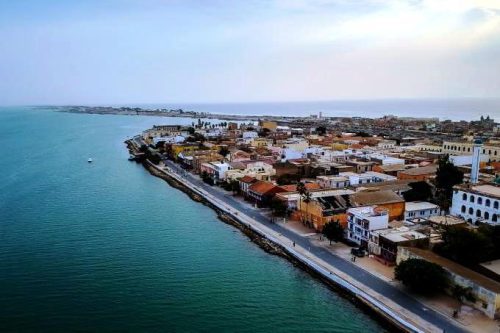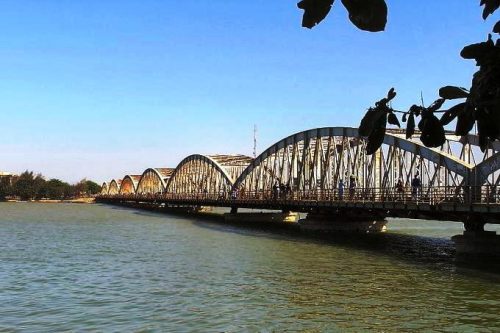Historic cities. Senegal. Saint Louis. The Venice of Africa.

Saint Louis, washed by the Senegal River and the Atlantic Ocean, is the most aquatic city on the West African coast.
Today Saint Louis is a city of 250,000 inhabitants. Its charm is unquestionable, it is one of those places where you feel good as soon as you arrive, without knowing exactly why. Built and broken like a cake into pieces of land on the waters of an ocean and a river, it is surrounded by beautiful corners with marshes and natural parks flown over by a diversity of birds, with pink flamingos and pelicans foremost.
Located at the mouth of the Senegal River, Saint Louis is divided into three areas: the island of N’Dar, which is the historical and colonial part, the Langue de Barberie or Guet N’Dar, where the fishermen live, and the mainland of Sor, the commercial, agricultural, university and contemporary area connected to the hinterland.

Aerial panorama of Sant Louis. View from Senegal river towards the old colonial city and fisherman island. Shutterstock/Anze Furlan
Saint Louis was declared a World Heritage Site in 2000 and is today a potpourri of all of Africa, of what the continent was and what it is, both in terms of richness and challenges.Its biggest attraction is itself: on the border with Mauritania, the entrance to the Sahara Desert for some and the exit for others. Here are just some of the highlights that help us better understand the soul of this African city.
Saint Louis, the Venice of Africa. “Water is very important in Saint Louis. The Atlantic Ocean nourishes and attacks it at the same time. The Senegal River nourishes its fields, gives life to its banks and occasionally bursts its banks at its mouth.
Its insular surface is a kind of miracle of nature. It is surrounded by water on all sides and remains afloat with astonishing tenacity. One has the feeling that its inhabitants are counting on its disappearance one day” (Lola Huete Machado, a Spanish journalist).
Saint Louis, the city of the caucos. Every evening, at sunset, one can witness a continuous coming and going of canoes crossing the waters of the Senegal River until they reach the Atlantic Sea. There are immense barges, painted in bright colours and full of flags and symbolism, prayers and good wishes. Each is entrusted to the respective marabou or the goddess who protects them from the wrath of the ocean.
In Saint Louis, everything revolves around fishing: social, economic, political, cultural, gastronomic, festive and environmental.

A young girl with a joyful smile on her face in a fishing village.123rf
Saint Louis, a mixed race. On the mainland, groups of many ethnic groups and nationalities coexist, of which the Wolof and the Lebu are the most numerous. The mestizo character, the mixture of cultures and the social conditions of the island have marked the inhabitants of this city. There has always been a deep respect for all people, regardless of their social status or religion.
Saint Louis, religions. Of Sunni tendency, Senegalese Muslims are divided into brotherhoods, which until now have represented an important check against the penetration of radical ideas from outside. Religion is very present in daily life and in celebrations such as Tabaski or Korité de Saint Louis. Interreligious coexistence is healthy: Muslims and Christians break the Ramadan fast together and religious holidays represent a moment of rapprochement between the different faiths.

Faidherbe Bridge, the symbol of the city. CC BY-SA 4.0/Manu25
Saint Louis, the migrant. The local economy suffered a strong negative impact around 2000 with the arrival of large foreign vessels carrying out industrial fishing operations. The fishermen of Guet N’Dar, who used to fish in front of their houses, were left without a catch and this led to the phenomenon of local emigration towards other African countries and Europe. In 2006-2007, during the so-called Cayuco crisis, around 50,000 young Africans, mostly Senegalese, crossed the Atlantic on board these boats. As a result, many St Louis families are headed by wives of husbands who live in Europe.
Saint Louis, the mainland. A few meters from the photogenic and colourful colonial city there is the other Saint Louis, the one with the markets and wooden stalls that can be seen in any African city. The rural exodus attracts dozens of young people to this other Saint Louis (called Sor) who leave agriculture and sheep-rearing in the interior of the region in search of a different future.

Pelicans on an island in the Barbarie National Park.CC BY-SA 4.0/Manu25
Saint Louis and its parks. The city has two national parks registered as World Heritage sites. The Djoujd Ornithological Park, the third largest ornithological reserve in the world, where every year thousands of birds migrate from southern and eastern Africa, Europe and Asia to the wetlands of the Senegalese coast to reproduce, to escape the winter or to transit towards other skies. The Langue de Barbarie National Park, near the mouth of the Senegal River, is home to numerous aquatic birds.
Saint Louis and culture. This city so rich in history is a constantly bustling laboratory of innovation and crossbreeding, according to the artists who enliven its lively cultural life with an annual jazz music festival, a photography museum and so on.
Saint Louis and its future. All experts highlight and doubt the future of this coastal city in Senegal, which is facing the danger of coastal erosion and high emigration. The effects of climate change, the harassment of the sea, the violence of the river and the threat of the desert threaten its long-term survival. The buildings and houses of the city begin to suffer. Suzanne Hirschi, an architect committed to safeguarding the urban heritage of Saint Louis, states that “the main challenge today is its very existence”. (Open Photo: Fishing boats parked on the shore in Sant Louis.123rf)
Juan José Osés/Africana



